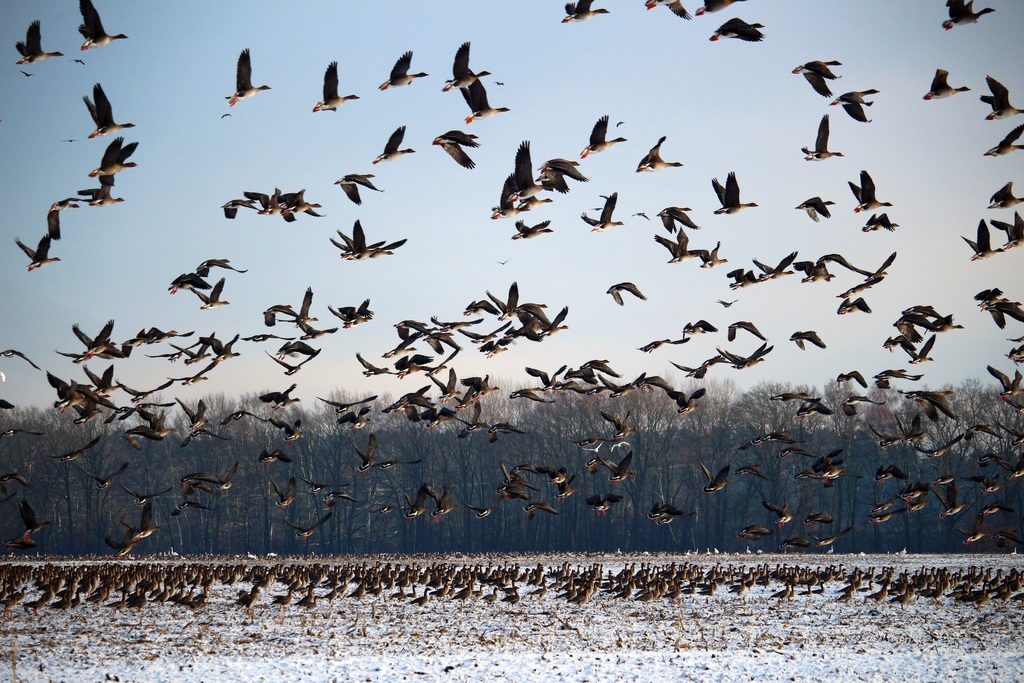Modern technology has given researchers enhanced ability to learn about the life habits and adaptations of migratory birds. It’s amazing how fast technology is evolving both in terms of data collection and its potential for aiding conservation efforts. But what remains unclear is whether birds will be able to adapt fast enough to survive the rapid changes taking place on the planet.
—
The science of studying birds or ornithology most likely dates back to human’s fascination with flight. Recorded observations are a more recent phenomenon. In the United States, some of the earliest recorded observations can be linked to the American naturalist and painter John James Audubon, who in the early 1800s, tied threads to birds’ legs as a means to identify individuals. A century later, scientists affiliated with the Smithsonian Institution used metal bands as a means of identifying individual herons. If and when the herons were recaptured, the bands provided data on the individual birds. This method is known as mark and recapture. It is still used to estimate the abundance of a population as well as track the movement of individuals.
Modern technology has provided an ever increasing number of ways to gather data on bird populations and individuals. Electronic tracking devices were once limited to the larger breeds of birds like Trumpeter Swans and Wandering Albatrosses because of the size of transmitters. The rule of thumb was that birds not be outfitted with transmitters that exceeded 3-5% of the bird’s body weight. Researchers needed some form of transportation to carry the cumbersome equipment. The emergence of transmitters that utilised the ARGOS satellite network in 1984 revolutionised ornithological studies. More recently, the development of lightweight sensors like geolocators that record light intensity and the even smaller nanotags that emit radio signals have led to the automation of radio telemetry. Reports also found ornithologists are even using “the International Space Station to receive data from the lightest GPS tags, adding to the bevy of options scientists have today.”
One unexpected collaborator in the study of migratory birds is the US National Weather Service (NWS). The NWS operates Doppler radar stations to track precipitation and other meteorological events. These can also be used to track the migration of birds at night while dual polarisation weather radar provides sufficient detail that ornithologists can distinguish the size of birds and the direction they are travelling. Notable American naturalist and Pulitzer Prize finalist Scott Weidensaul noted that weather radar images have been collected for decades and that researchers have enough computing power to take the accumulation of millions and millions of radar images to look back in time and calculate how the number of migratory birds has changed. Based on the data, scientists are near certain that a third of North America’s birds have disappeared. That’s almost three billion birds.
Technological advancements have also shed light on other aspects of bird migration. We know that the bar-tailed godwit is a super-marathon migrator. According to Weidensaul, this shorebird travels some 11,000km, nonstop across the Pacific Ocean from West Alaska to New Zealand. In 2021, an adult male had even set the world record for the longest continuous flight by any land bird. It had flapped its wings for 239 hours, covering 13,000km. This record was verified by a solar-powered location tracker attached to the bird.
The godwit, however, is not the avian long distance-record holder. That title belongs to the Arctic tern, which is a seabird. It is able to land on water and feeds by plunging into the ocean to catch small fish. Although they spend much of their year offshore, they need land to nest and raise their chicks. They nest in the Arctic and then travel to Antarctica in order to avoid the northern winter and enjoy the southern summer. It’s a pole-to-pole journey covering about 40,000km annually. Their long distance record is compounded by the fact that Arctic terns are long-lived birds. The oldest recorded Arctic tern was about 34 years old, which means it probably travelled more than three quarters of 1.6 million km during its lifetime.
You might also like: Shenzhen Skyscrapers Threaten Migratory Bird Populations in Hong Kong Wetland
Some things ornithologists have learned over the years without the aid of modern technology is how these long distance fliers are able to physically handle the demands of physical endurance. Like human marathoners, the long distance-flyer binge feeds. Alaska godwits that nest along coastal and estuarine mudflats use their long beaks to feed on crustaceans, mollusks, and insects in the mud. They can double their weight and fat composition until as Weidensaul describes them: they become as jiggly as water balloons. That’s not all that gets bigger. The godwit’s heart and flight muscles also increase 50% by mass. When they’ve eaten enough to build a surplus of fat for the migratory flight, their digestive system shrinks. At the end of the migration when their fat reserves have been depleted, the gut is regrown and the bird begins to store food energy. A few months later, the body will prepare for the return journey.
Another amazing adaptation is that some migratory birds evolved a special way to sleep during long migratory journeys. Unihemispheric sleep allows one half of the brain to nap for a few seconds. It then wakes up and gives the other half a brief nap. This continues through the entire journey. The birds also have a way to satisfy the thirst that comes with sustained activity by being able to biochemically extract water from their organs and muscle tissues.
The continued evolution of technology extends to the worldwide mobile phone network, which has been used to track animals and offer high spatial and temporal resolution for following bird movements. The cell phones in our pockets have the power to turn us all into high-tech ornithologists. These advances also have the power to change conservation by fast-tracking efforts to save birds. Building operators in American cities like Houston and Pittsburgh have started implementing new monitoring technologies as a way to reduce bird collisions, including BirdCast, which provides “forecasts for evenings of heavy overall bird migration, when lights should be dimmed to reduce building collision risks.” In the future, collision risk–mitigation models might be applied to powering down wind turbines on high-migration nights.
Thanks to technological advances we’ve come a long way in learning about the life habits and adaptations of migratory birds. It’s amazing how fast technology is evolving and equally gratifying to learn how birds have adapted to the demands of life on Earth. One important and unresolved question is: can birds, like technology, adapt fast enough to the rapid changes brought about by humans and their technology to survive?
Featured image by: PxHere


















